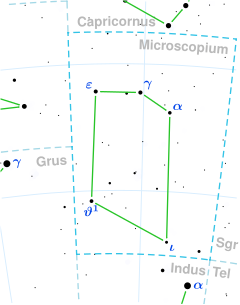| Observation data Epoch J2000 Equinox J2000 | |
|---|---|
| Constellation | Microscopium |
| Right ascension | 21h 17m 56.28399s[1] |
| Declination | −32° 10′ 21.1515″[1] |
| Apparent magnitude (V) | 4.71[2] |
| Characteristics | |
| Spectral type | A1V[3] |
| U−B color index | +0.02[4] |
| B−V color index | +0.06[4] |
| Astrometry | |
| Radial velocity (Rv) | +7.20[5] km/s |
| Proper motion (μ) | RA: +54.36[1] mas/yr Dec.: −23.29[1] mas/yr |
| Parallax (π) | 19.7054 ± 0.5472 mas[6] |
| Distance | 166 ± 5 ly (51 ± 1 pc) |
| Absolute magnitude (MV) | 0.97[2] |
| Details | |
| Mass | 2.18[7] M☉ |
| Radius | 2.2[7] R☉ |
| Luminosity | 35.62[2] L☉ |
| Surface gravity (log g) | 4.37[8] cgs |
| Temperature | 9,126[8] K |
| Metallicity [Fe/H] | −0.01[9] dex |
| Rotational velocity (v sin i) | 127[3] km/s |
| Age | 525[8] Myr |
| Other designations | |
| Database references | |
| SIMBAD | data |
Epsilon Microscopii, Latinized from ε Microscopii, is a single,[10] white-hued star in the southern constellationof Microscopium. It is faintly visible to the naked eye with an apparent visual magnitude of 4.71.[2] The annual parallax shift of the star is 19.7054 mas[1] as measured from Earth, which yields a distance estimate of around 166 light years. It is moving further from the Sun with a radial velocity of +7 km/s.[5]
This star has a stellar classification of A1 V,[3] indicating it is an A-type main-sequence star that is generating energy through hydrogen fusion at its core. The stellar spectrum displays an overabundance of silicon in the star's atmosphere,[11] but the abundance of iron is the same as in the Sun.[9] The star has 2.2 times the mass of the Sun and 2.2 times the Sun's radius.[7] It is around a half billion years old[8] and is spinning rapidly with a projected rotational velocity of 127 km/s.[3] Epsilon Microscopii is radiating about 36 times the Sun's luminosity[2] from its photosphere at an effective temperature of 9,126 K.[8]
Epsilon Microscopii was a latter designation of the star 4 Piscis Austrini.[12]
This star was the brightest star in the obsolete constellation Globus Aerostaticus.[13]
References
- ^ a b c d e Van Leeuwen, F. (2007). "Validation of the new Hipparcos reduction". Astronomy and Astrophysics. 474 (2): 653–664. arXiv:0708.1752. Bibcode:2007A&A...474..653V. doi:10.1051/0004-6361:20078357. S2CID 18759600. Vizier catalog entry
- ^ a b c d e Anderson, E.; Francis, Ch. (2012). "XHIP: An extended hipparcos compilation". Astronomy Letters. 38 (5): 331. arXiv:1108.4971. Bibcode:2012AstL...38..331A. doi:10.1134/S1063773712050015. S2CID 119257644. Vizier catalog entry
- ^ a b c d Hoffleit, D.; Warren, W. H. (1995). "VizieR Online Data Catalog: Bright Star Catalogue, 5th Revised Ed. (Hoffleit+, 1991)". VizieR On-line Data Catalog: V/50. Originally Published in: 1964BS....C......0H. 5050. Bibcode:1995yCat.5050....0H.
- ^ a b Mallama, A. (2014). "Sloan Magnitudes for the Brightest Stars". The Journal of the American Association of Variable Star Observers. 42 (2): 443. Bibcode:2014JAVSO..42..443M.Vizier catalog entry
- ^ a b Gontcharov, G. A. (2006). "Pulkovo Compilation of Radial Velocities for 35 495 Hipparcos stars in a common system". Astronomy Letters. 32 (11): 759–771. arXiv:1606.08053. Bibcode:2006AstL...32..759G. doi:10.1134/S1063773706110065. S2CID 119231169.
- ^ Brown, A. G. A.; et al. (Gaia collaboration) (August 2018). "Gaia Data Release 2: Summary of the contents and survey properties". Astronomy & Astrophysics. 616. A1. arXiv:1804.09365. Bibcode:2018A&A...616A...1G. doi:10.1051/0004-6361/201833051. Gaia DR2 record for this source at VizieR.
- ^ a b c Allende Prieto, C.; Lambert, D. L. (1999). "Fundamental parameters of nearby stars from the comparison with evolutionary calculations: Masses, radii and effective temperatures". Astronomy and Astrophysics. 352: 555–562. arXiv:astro-ph/9911002. Bibcode:1999A&A...352..555A. Vizier catalog entry
- ^ a b c d e David, Trevor J.; Hillenbrand, Lynne A. (2015). "The Ages of Early-Type Stars: Strömgren Photometric Methods Calibrated, Validated, Tested, and Applied to Hosts and Prospective Hosts of Directly Imaged Exoplanets". The Astrophysical Journal. 804 (2): 146. arXiv:1501.03154. Bibcode:2015ApJ...804..146D. doi:10.1088/0004-637X/804/2/146. S2CID 33401607. Vizier catalog entry
- ^ a b Gontcharov, G. A. (2012). "Dependence of kinematics on the age of stars in the solar neighborhood". Astronomy Letters. 38 (12): 771–782. arXiv:1606.08814. Bibcode:2012AstL...38..771G. doi:10.1134/S1063773712120031. S2CID 118345778. Vizier catalog entry
- ^ Eggleton, P. P.; Tokovinin, A. A. (September 2008). "A catalogue of multiplicity among bright stellar systems". Monthly Notices of the Royal Astronomical Society. 389 (2): 869–879. arXiv:0806.2878. Bibcode:2008MNRAS.389..869E. doi:10.1111/j.1365-2966.2008.13596.x. S2CID 14878976.
- ^ Renson, P.; Manfroid, J. (May 2009), "Catalogue of Ap, HgMn and Am stars", Astronomy and Astrophysics, 498 (3): 961–966, Bibcode:2009A&A...498..961R, doi:10.1051/0004-6361/200810788.
- ^ Wagman, M. (August 1987). "Flamsteed's Missing Stars". Journal for the History of Astronomy. 18 (3): 220. Bibcode:1987JHA....18..209W. doi:10.1177/002182868701800305. S2CID 118445625.
- ^ Ian Ridpath's Star Tales - Globus Aerostaticus

